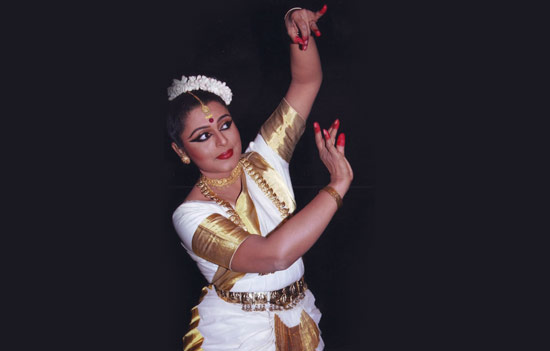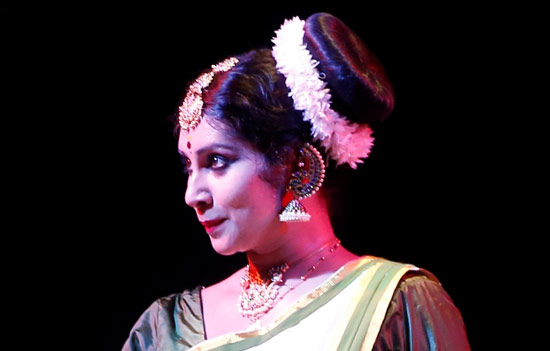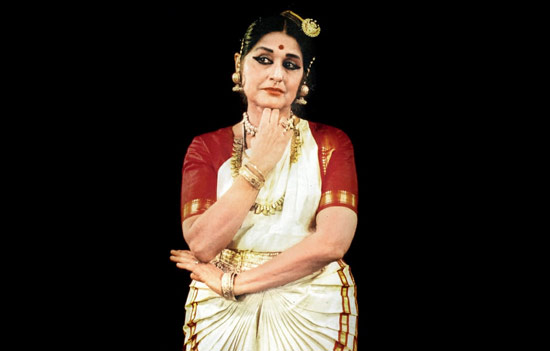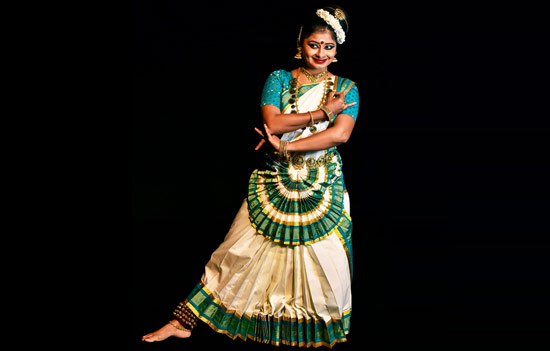- Know about origin, evolution and technique of Mohiniattam, establishing of Kerala Kalamandalam and Dr Kanak Rele’s outstanding contribution.
Mohiniattam
is the dance of the enchanteress and not the dance of the seductress, as
normally misunderstood by many. Mohiniattam is the elegant, lyrical classical
dance of Kerala, prevailing for centuries and is normally performed by women.
The dance movements symbolise the exquisite swaying of the palm trees of
Kerala.
Mohiniattam
is based on the lasya concept of
dancing, which is the feminine, graceful style of dancing, initiated by goddess
Parvati.
Origin and evolution
According to Hindu tradition and in varied sacred texts, there are various references to the word “Mohini” and the evolution of “Mohiniattam”. During Amruta Manthan (churning of the ocean)
in order to seek the nectar of immortality, the tussle between the Devas (Gods) and asuras (demons), the demons almost succeeded and was about to
snatch the pot of nectar but Lord Vishnu appeared as the beautiful damsel
Mohini and took away the pot of nectar. Hence, Mohini is referred to as the
beautiful woman of enchantment. The word Mohini is the derivative of the words
Mohit and Moham.
Another
popular story of Mohiniattam, is the story of the demon Bhasmasura. Bhasmasura was an ardent devotee of Lord
Shiva and due to his penance, the Lord was pleased to grant him boons that he
wanted. Bhasmasura asked for the boon that whosoever head he keeps his hand on,
they will perish. The boon is granted and the excited demon wanted to try it on
Lord Shiva itself. Shiva ran for his life and meets Lord Vishnu who convinces
Shiva and tells him not to worry. Lord Vishnu appears as the beautiful and
enchanting Mohini and meets the demon. The demon is completely enchanted by her
beauty as he proposes for marriage. Vishnu agrees and tells him that he could
marry on the condition that he dances with her. The demon starts dancing with
lot of enthusiasm and excitement. In the process places his hand on his head
and immediately perishes.
 Artist Saji Menon.
Artist Saji Menon.
Devadasis or servants of the Lord
Young
teenaged girls were married to the Lord, in a temple ritual that prevailed in
the 19th century. These girls were known as Devadasis or servants of the Lord.
They learnt classical music and dance and performed regularly during social or
religious occasions. The four styles adversely affected by the devadasi
tradition were Bharata Natyam, Mohiniattam, Odissi and Manipuri.
Bharata
Natyam was referred to Dasiattam, Sadir or the vadachi attam. In fact the word Mohiniattakari was a slang used as a form of abuse to describe a lady who had illicit relationships, while in the east, Odissi dancers were known as "maharis" and Manipuri dancers were known as "Meibis". The Britishers intervened and abolished it through the Devadasi Prevention Act. Unfortunately classical dancers suffered a stigma, hence girls and respectable families were not even allowed to watch a classical dance performance, as they were all devadasis.
After
the establishment of Kerala Kalamandalam in 1930 by Mahakavi Vallathol, it was
not easy to induce girls from respectable families to learn Mohiniattam. In fact
Rukmani Devi Arundale was a pioneer who encouraged girls from respectable
families to learn Bharata Natyam, describing the dance as sacred. Lawyer and
dance critic E Krishna Iyer donned female attire in order to attract the
attention of people, towards the sanctity of classical dance. Poet Rabindranath
Tagore too intervened to give classical dance a new respectability.
Originally the devadasis were confined to the temples, but slowly they moved further on dancing to the tune of rich zamindars, chieftans and ultimately at the royal courts of kings. That is when the degradation of devadasis started, as the dance of the spirit was transformed to the dance of the body. The dancers did receive royal patronage but the sanctity of classical dances was deteriorating until great poets and social reformers like Mahakavi Vallathol and Rabindranath Tagore intervened to give dance a new respectability. Meanwhile the Britishers described the devadasis as “nautch girls” and finally the devadasi movement was banned by the Government. It is not only the devadasis but the society is equally responsible for their degradation.
 Artist Deepti O Bhalla.
Artist Deepti O Bhalla.
Mahakavi Vallathol establishes Kerala Kalamandalam
Poet
Mahakavi Vallathol established Kerala Kalamandalam in 1930 at Cheruthuruthy.
The intent was to induce and convince everyone that classical dances are
essentially sacred, hence children and youngsters should come forward to learn
these dance forms; Kathakali and Mohiniattam was taught but it was not easy to
get teachers and students to learn.
The first teacher of Mohiniattam was Kalamandalam Kalyani Kutty Amma, wife of the legendary Kathakali actor Kalamandalam Krishnan Nair. Kalyani Kutty Amms’s two daughters and grand-daughter Smitha Rajan are professional Mohiniattam exponents and mentors.
 Artist Mythili Anoop.
Artist Mythili Anoop.
Besides Kalyani Kutty Amma, several dancers and teachers have learnt Mohiniattam from Kalamandalm, the premier centre for performing arts in India, Kalamandalam Satyabhama, Sugandhi’, Nirmala Panikkar and Kalamandalm Kshemavathy are among the senior most exponents. Some devoted dancers are Gopika Varma, who belongs to the royal family of Travancore, Shyamala Surendran, Jayaprabha Menon, Ayswaria Warrier, Geeta and Radhika Radhakrishna, Jayashree and Sujata Nair, Geeta Vijay S, Neena Prasad, Pallavi Krishnan, Rachita Ravi and Mythili Anoop etc
 Padma Bhushan Dr Kanak Rele.
Padma Bhushan Dr Kanak Rele.
Padma Bhushan Dr Kanak Rele’s outstanding contribution
In spite of being a non-Malayalee, Padma Bhushan Dr Kanak Rele’s contribution towards propagation and enrichment of Mohiniattam is immense. In fact she is the only Mohiniattam dancer to be the recipient of the prestigious Padma Bhushan award. Kanak is the disciple of Kathakali exponent “Panchali” Karunakara Panicker. After receiving a grant from Ford Foundation, Kanak made a documentary on the three pioneer Mohiniattam exponents: Kalyani Kutty Amma, Chinnamuamma and Kunju Kutty Amma.
She also evolved her own style with music, in the traditional Sopanam Sangeetam style, composed by Kavalam Narayan Panikkar. Kanak has introduced several new choreography projecting women empowerment with items like Amba and Draupadi. Kubja and Kalyani based on Tagore’s Chandalika. She has
several performances all over the globe to the credit. Kanak has also written
books on Mohiniattam, Bhava Nirupana,
Dance vocabulary etc.
 Artist Dimple Nair.
Artist Dimple Nair.
Dr
Kanak is a dance educationist too. She has established Nalanda Dance Research Centre’s Nalanda Nritya
Kalamahavidyalya with degrees in dance up to the doctorate level. It is affiliated
to Mumbai University and has trained several dancers, many of them are
professional dancers and teachers like Madhuri Deshmukh, Dimple Nair (Doha), Sunanda
Nair (USA) and young brilliant dancers Saji Nair and Megha Ahire Mohad. Mandakini
Trivedi is a senior disciple who has won the Sangeeta Natak Akademi award.
 Artist Saji Menon.
Artist Saji Menon.
Technique and music
While
Mohinattam is considered an off shoot of both Bharata Natyam and Kathakali, the
movements are slow, graceful and lyrical. This is enchanting and creates a fine
visual appeal. While Kalamandalam follows its own bani (style), Dr Kanak Rele’s style has also become immensely popular.
Dr
Geeta Radhakrishna has written and illustrated an exclusive book on Mohiniattam adavus and Mudras which is
based on Hasta Lakshana Deepika, Natya Sastra, Abhinaya Darpana, Sangeeta
Ratnakara and Bharatarnava. 150 adavus (dance units) and 24 mudras (hand gestures) are portrayed.
Geeta has also written Mohiniattam – dance of the enchanteress and other books.
Music
is in both Carnatic and Sopanam styles. The themes are drawn from Hindu tradition
and compositions used are of Maharaja Swati Tirunal and poet Irayimman Thampi.
Mohiniattam Overseas
Besides Dr Kanak Rele’s performances in different countries, other dancers who have performed overseas include Bharati Shivaji, Deepti Omcherry bhalla, Jayaprabha Menon, Geeta Radhakrishna,Ayswaria Warrier, Gopika Varma etc.
To read all
articles by author
To read all articles on
Indian Dance
Experiencing
Theyyam Dance of Kerala
To
read Arts, Crafts Dance traditions of Kerala
To read a Paper on the Devdasi System
Guru Vijay Shanker is a professional Kuchipudi, Kathakali
exponent, dance teacher, choreographer, actor and arts critic for over four
decades, contributing for national and international publications. He is
particularly credited for his lecture-demonstrations on Indian classical
dancing which is a fine combination of both education and entertainment.